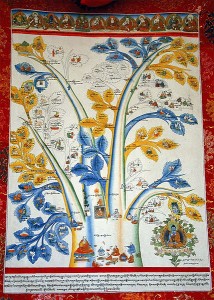TUESDAY, 20 JULY 2010
Richard Ernst is one of the forefathers of the analytical technique known as nuclear magnetic resonance (NMR). The Nobel Prize was awarded solely to him in 1991, "for his contributions to the development of the methodology of high resolution NMR spectroscopy." In this talk, he addressed an international community of magnetic resonance scientists whose work is based on the fundamentals laid by Ernst.Since 1968, Ernst has had a passion for collecting Tibetan thangkas. In order to understand the chemical composition of their paint pigments in a completely non-invasive manner, he has had to utilise techniques beyond NMR. Infra-red spectroscopy is one such technique. It allows you to can see through certain layers of coloured paint to the black ink underneath. The technique was applied to an 18th century painting that depicts the workshop of the master painter Zhu-chuen. The master painter initially outlined the thangka. Monks and lay painters then applied coloured pigments. To denote which areas were to be painted which colour, the master used single-letter codes, these have been revealed by the infra-red camera.
Another technique is Raman spectroscopy. This allows the chemical composition of the paint to be determined non-destructively and enables Nepalese and Tibetan paintings to be distinguished. Nepalese paintings contain a green colour, which is a mixture of indigo (blue) and orpiment (yellow) pigments, while Tibetan uses malachite which is a bright green pigment. One of the risks of using Raman spectroscopy is that holes can be burnt into the painting if the laser power is too high. While possibly horrifying museum conservators, he claims that the holes are so small that if he looks at another area and then returns, he can't find the holes again!
These investigations are carried out in his own home, where his collection of thangkas is housed in the rooms which used to be occupied by his children. His paintings and art give him a passion, which is driven by his professional interest in understanding aspects of the paintings scientifically. It was a very enjoyable and inspiring lecture given by one of the great scientists of our time.
Written by Wing Ying Chow

